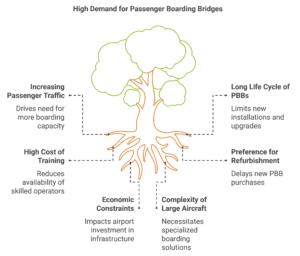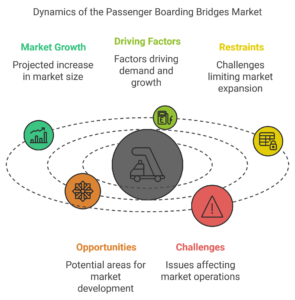Passenger Boarding Bridges (PBBs) are essential components in modern airport infrastructure, providing a safe and convenient way for passengers to board and deplane aircraft. With the increasing demand for air travel, the Passenger Boarding Bridges Industry is experiencing rapid growth, expected to expand from USD 273 million in 2020 to USD 489 million by 2025 at a CAGR of 12.3%. The demand for PBBs is driven by growing passenger traffic, airport modernization projects, and technological advancements aimed at enhancing passenger experience and operational efficiency.
What are Passenger Boarding Bridges?
Passenger Boarding Bridges, also known as aerobridges, are enclosed, movable structures connecting airport terminals to aircraft doors. PBBs are designed to facilitate safe, convenient, and efficient boarding and deplaning of passengers, especially in large airports with high footfall. These bridges accommodate various aircraft types by extending and retracting and can adjust their height to match the aircraft’s doors.
How Do Passenger Boarding Bridges Work?
PBBs typically consist of a rotunda, an elevation system, and a telescopic corridor. Here’s a breakdown of how they function:
- Positioning: After an aircraft is parked, the boarding bridge is maneuvered into position using a set of controls. Operators adjust the elevation of the bridge to align with the aircraft door.
- Telescopic Extension: PBBs extend and retract based on the distance between the terminal and the aircraft, allowing flexibility to reach various aircraft door heights and positions.
- Docking and Sealing: Once aligned, the bridge’s corridor extends to the aircraft door, and a rubber seal encloses the door area, protecting passengers from external weather conditions.
- Boarding/Deplaning: With the bridge securely in place, passengers can safely board or deplane directly from the terminal without exposure to the tarmac or potential hazards.
Passenger Boarding Bridges Market Growth Drivers
- High Demand for Larger Aircraft: Increased passenger volume necessitates larger aircraft with more boarding gates, which in turn drives the need for more advanced PBBs. Larger aircraft, such as the Airbus A380 and Boeing 747-8, require specialized PBBs capable of accommodating multi-door boarding.
- Increase in Airport Construction and Modernization Projects: Airports are expanding to accommodate rising passenger traffic. Greenfield (new) and brownfield (expansion/modernization) projects are underway globally, focusing on enhancing terminal infrastructure, including PBB installations.
- Public-Private Partnerships (PPPs): PPPs are becoming increasingly popular, especially in regions with limited funds for airport development. Governments and private companies collaborate to develop and maintain airport infrastructure, with PBBs being essential to enhancing passenger experience and safety.
- Technological Advancements in Passenger Boarding Bridges: Innovations such as automated docking, real-time diagnostics, and environmentally friendly features are transforming PBBs. Automated systems reduce the need for skilled labor and minimize docking time, which is crucial for maintaining efficient operations.
- COVID-19 and Recovery: The COVID-19 pandemic initially led to a decline in air travel, temporarily reducing demand for PBBs. However, as air travel gradually recovers, the need for modernized, hygienic, and efficient boarding solutions is on the rise, supporting PBB market growth.
Download PDF Brochure: https://www.marketsandmarkets.com/pdfdownloadNew.asp?id=69975937
Key Opportunities in the Passenger Boarding Bridges Market
- Emergence of Smart Airports: Smart airports, which emphasize the use of IoT, AI, and digital solutions, present opportunities for PBB manufacturers to integrate advanced technology. These systems can monitor bridge operations, assess docking accuracy, and provide real-time feedback, ensuring seamless passenger experiences.
- Expansion in Emerging Markets: Airports in regions such as Asia Pacific, Latin America, and Africa are expanding due to growing passenger traffic. These regions have numerous projects for new airports or expansion, creating a strong demand for PBBs.
- Customization and Aesthetic Appeal: Airports are increasingly focusing on custom-built PBBs with features like glass walls, which offer a transparent boarding experience, aligning with green airport requirements. This trend is creating demand for innovative PBB designs that meet both aesthetic and functional standards.
- Investment in Sustainability: Many airports are investing in energy-efficient infrastructure, including PBBs with minimal environmental impact. Sustainable PBBs consume less energy and contribute to an airport’s environmental goals.
Key Players in the Passenger Boarding Bridges Market
The passenger boarding bridges market is dominated by globally established Key Companies, including:
- ThyssenKrupp AG (Germany): A leader in PBB technology, providing solutions across various airports globally, including cutting-edge docking systems.
- John Bean Technologies Corp. (JBT) (US): Known for a strong presence in North America, JBT offers a range of PBB solutions tailored for commercial aviation.
- CIMC Ltd. (China): A major supplier in Asia Pacific, CIMC specializes in manufacturing automated and manual PBBs for large international airports.
- FMT Aircraft AB (Sweden): Known for its extensive customization options, FMT offers PBBs to accommodate various aircraft sizes.
- ADELTE Group (Spain): Focuses on technologically advanced PBBs for both aviation and maritime industries, recently expanding operations in North America.
Recent Developments in the Passenger Boarding Bridges Market
- Anton Air Support: In March 2020, Anton Air Support installed three PBBs at the Landvetter Airport in Sweden, which included new mechanical installations, ensuring operational efficiency.
- CIMC: In 2019, CIMC secured a contract to supply unmanned jet boarding bridges for operations in the Netherlands, signifying the growing demand for automation in PBBs.
- ThyssenKrupp: Entered into a contract in 2019 to install 42 modern PBBs at Adolfo Suárez Madrid-Barajas Airport, Spain. This contract also includes maintenance of 122 PBBs, highlighting the importance of long-term relationships in the market.
- ADELTE: In 2019, ADELTE secured contracts from three US cruise ports to deliver seaport PBBs, expanding its market presence into maritime passenger boarding systems.
FAQs About Passenger Boarding Bridges
1. What is the future of the Passenger Boarding Bridges Market?
The market is expected to grow steadily, with the increasing demand for large aircraft and airport modernization projects driving expansion.
2. What sustainability strategies are companies adopting in this market?
Companies focus on reducing environmental impact by designing energy-efficient, automated, and recyclable PBBs, aligning with airport sustainability goals.
3. Which regions are leading the market for Passenger Boarding Bridges?
North America holds the highest market share due to mature infrastructure and ongoing expansions, followed by Europe and the Asia Pacific.
4. How does automation impact the Passenger Boarding Bridges market?
Automation improves safety and efficiency, reducing the need for skilled labor and enhancing operational precision, which is a significant trend in the PBB industry.
To Gain Deeper Insights Into This Dynamic Market, Speak to Our Analyst Here: https://www.marketsandmarkets.com/speaktoanalystNew.asp?id=69975937
Key Takeaways
- Market Growth: The global Passenger Boarding Bridges Market is projected to grow from USD 273 million in 2020 to USD 489 million by 2025, driven by increased air traffic, airport projects, and technological advancements.
- Innovations in PBBs: Automation and sustainability are central to modern PBBs, with smart and eco-friendly models transforming airport infrastructure.
- Regional Trends: North America leads the PBB market due to its advanced airport infrastructure, while Asia Pacific is expected to witness rapid growth.
- Key Players: ThyssenKrupp, JBT Corp, CIMC Ltd., and ADELTE are prominent in the PBB industry, focusing on expanding their product portfolios and enhancing customer experience.
- COVID-19 Impact: Though the pandemic caused short-term setbacks, a steady recovery is expected as airports continue to upgrade facilities to improve passenger safety and satisfaction.
Passenger Boarding Bridges play a crucial role in airport operations and passenger convenience, making their market an essential component of the aviation sector’s evolution.

